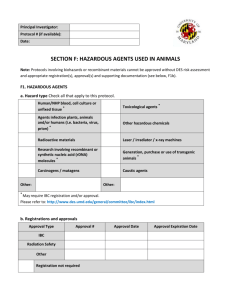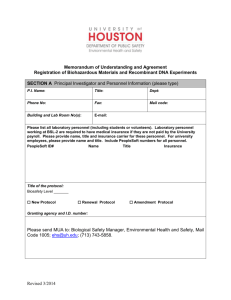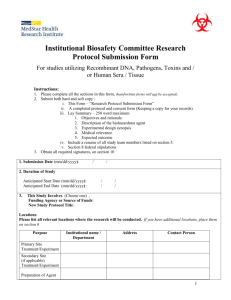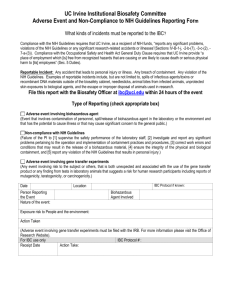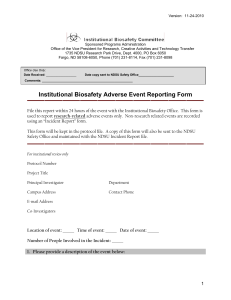IBC link -- new form in word format
advertisement
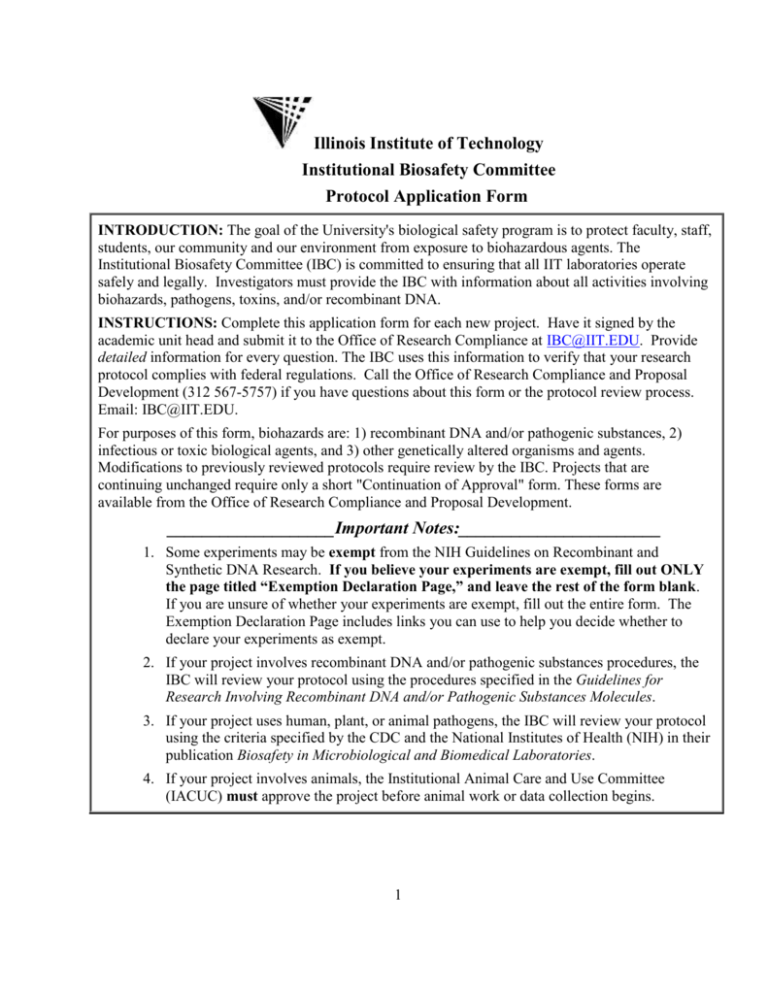
Illinois Institute of Technology Institutional Biosafety Committee Protocol Application Form INTRODUCTION: The goal of the University's biological safety program is to protect faculty, staff, students, our community and our environment from exposure to biohazardous agents. The Institutional Biosafety Committee (IBC) is committed to ensuring that all IIT laboratories operate safely and legally. Investigators must provide the IBC with information about all activities involving biohazards, pathogens, toxins, and/or recombinant DNA. INSTRUCTIONS: Complete this application form for each new project. Have it signed by the academic unit head and submit it to the Office of Research Compliance at IBC@IIT.EDU. Provide detailed information for every question. The IBC uses this information to verify that your research protocol complies with federal regulations. Call the Office of Research Compliance and Proposal Development (312 567-5757) if you have questions about this form or the protocol review process. Email: IBC@IIT.EDU. For purposes of this form, biohazards are: 1) recombinant DNA and/or pathogenic substances, 2) infectious or toxic biological agents, and 3) other genetically altered organisms and agents. Modifications to previously reviewed protocols require review by the IBC. Projects that are continuing unchanged require only a short "Continuation of Approval" form. These forms are available from the Office of Research Compliance and Proposal Development. ___________________Important Notes:_______________________ 1. Some experiments may be exempt from the NIH Guidelines on Recombinant and Synthetic DNA Research. If you believe your experiments are exempt, fill out ONLY the page titled “Exemption Declaration Page,” and leave the rest of the form blank. If you are unsure of whether your experiments are exempt, fill out the entire form. The Exemption Declaration Page includes links you can use to help you decide whether to declare your experiments as exempt. 2. If your project involves recombinant DNA and/or pathogenic substances procedures, the IBC will review your protocol using the procedures specified in the Guidelines for Research Involving Recombinant DNA and/or Pathogenic Substances Molecules. 3. If your project uses human, plant, or animal pathogens, the IBC will review your protocol using the criteria specified by the CDC and the National Institutes of Health (NIH) in their publication Biosafety in Microbiological and Biomedical Laboratories. 4. If your project involves animals, the Institutional Animal Care and Use Committee (IACUC) must approve the project before animal work or data collection begins. 1 EXEMPTION DECLARATION PAGE (if not exempt, then leave this entire page blank, and go on to the next page) Project Title: Investigator Name(s) Department/Phone Email * Principal Investigator must be IIT faculty List the exempt material(s) here and attach additional pages if necessary. You MUST provide the category and the applicable section of the NIH guidelines for the exemption: Principal Investigator’s Affirmation: The above declaration of exemption is correct to the best of my knowledge. SIGNATURE: X___________________________________________________________ NOTE: You do not need additional signatures for a declaration of exemption. Only the PI’s signature is required. Use these resources to determine whether your materials are exempt: Frequently Asked Questions About Experiments Exempted from NIH Guidelines on Recombinant and Synthetic DNA Research http://oba.od.nih.gov/oba/ibc/faqs/faqs_about_experiments_that_are_exempt_from_the_nih_guidelin es.pdf Frequently Asked Questions Recombinant and Synthetic DNA http://oba.od.nih.gov/oba/faqs/Synthetic_FAQs_March_2013.pdf NIH Guidelines Recombinant and Synthetic DNA Experiments March 2013 http://oba.od.nih.gov/oba/rac/Guidelines/NIH_Guidelines_prn.pdf 2 Project Identification Project Title: Investigator Name(s) Department/Phone Email * Principal Investigator must be IIT faculty * Grant Proposal Titles OSRP ID # * Project Objective: * Project Start and End Dates: * Research Location: * What safety/equipment containment is present at this location? 3 Biohazard Summary For each type of biohazard used in this protocol, complete and attach the additional forms listed in the Required Forms column. Type Agent/Organism(s) Biosafety Level Required Forms Recombinant DNA and/or pathogenic substances "Recombinant DNA and/or pathogenic substances" page R-1 Parasites "Biological/Microbiological Hazards," page H-1 Fungi Bacteria Rickettsia Viruses (all types) Experimental Animals (used for pathogen research) "Experimental Animals/Cell Culture," page E-1 Cell Culture (used for pathogen research) Biotoxins "Biotoxins," page B-1 Project Description For all research involving biohazards as defined on page A-2: Summarize the proposed activity. In particular, describe what systems you plan to start with, what your endpoint is, what types of manipulations you plan to use to achieve that goal, and whether you anticipate any complications in that process. Use an additional page, if necessary. Also, provide any additional material (publications, diagrams) that might help the IBC review the activity. * 4 Personnel and Experience List the names, positions, and (very briefly) the biosafety background of all investigative staff (students and technicians) currently working on or involved with this research protocol. Please use an additional page, if necessary. You must update this information whenever your staff changes. Name Position Phone Degree Years Experience Biological/Microbiological Hazard Complete this section for all activities involving hazardous biological and microbiological agents. In the Type column, specify all of the following that apply: parasitic, fungal, bacterial, rickettsial, and viral. In the Pathogen column, specify all of the following that apply: human, animal, plant, and if plant, whether plant is indigenous to Illinois. To determine Biohazard Class, refer to the U.S. Public Health Service publication Classification of Etiologic Agents on the Basis of Hazard (4th Edition; DHEW, CDC, Atlanta, GA). If you cannot locate the appropriate classification(s), a letter of classification from the relevant agency must be attached to this form. To determine Biosafety Level, refer to the CDC/NIH publication Biosafety in Microbiological and Biomedical Laboratories (HHS Publication No. (CDC) 93-8395; 3rd edition; May 1993). Agent Type Pathogen * 5 Biohazard Class Biosafety Level Nature of Hazard State succinctly the nature of the hazard to which your staff is exposed and the possible consequences of accidental human exposure to or infection with the agent(s) with which you work. Include each potential danger and its pathway (e.g., contact, inhalation, ingestion). * Human Substances If blood components, secretions, or tissues are used in your work, briefly identify their source and use. Substance Source Use * Special Containment/Disposal/Surveillance Practices Describe any special practices and procedures you use to ensure that biohazards are managed safely and that faculty, staff, and students are protected from and monitored for exposure. * Recombinant DNA and/or pathogenic substances Complete this section for all activities involving recombinant DNA and/or pathogenic substances. If you cannot locate the appropriate classification(s), a letter of classification from the relevant agency must be attached to this form. List host, vector, and sources so that H1, V1, and S1 correspond. Host Organism with Strain Number Genotype Classification (Appendix B, p.16967) H1 * H2 6 H3 H4 Corresponding Vectors V1 V2 V3 V4 Inserted DNA Sources S1 S2 S3 S4 Do you use a helper virus? * Do you deliberately attempt to obtain expression of a foreign gene? If yes, what protein is produced? * Specify the level of physical containment you use; i.e., exempt, BL1, BL2, BL3, or BL4, as defined in Appendix G, p.16972. * Specify the level of biological containment you use; i.e., exempt, A1, A2, B3, or B4, as defined in Appendix I, p.16980. * Experimental Animals/Cell Culture Complete this section for all activities evaluating the effects of pathogens or other biohazards on experimental animals or cell cultures. Notes: 1. Investigators are responsible for ensuring that all laboratory animal facilities, operational practices, and quality of animal care meet applicable standards and regulations and that appropriate species have been selected for animal experiments (e.g., Guide for the Care and Use of Laboratory Animals, National Academy Press, 1996, and Laboratory Animal Welfare Regulations-9 CFR, Subchapter A, Parts 1, 2, and 3. 2. Refer to the CDC/NIH publication Biosafety in Microbiological and Biomedical Laboratories (HHS 7 Publication No. (CDC) 21-1112; 4th edition; Dec 2009) for more information about managing biohazardous activities involving experimental animals. Common Name of Species Purpose of Use Animal's Location (Building and Room #) Biohazard Level * Materials Administered Identify all substances that are administered to the experimental animals in your work. Substance Quantity Technique Used * Cell Cultures Identify species, source, and use of cell cultures in this protocol. Culture Name Organism Organ Source Special Containment/Disposal Practices Describe any special practices and procedures you use to ensure that biohazards are managed safely. * 8 Use Biotoxins Complete this section for all activities involving biotoxins. In the Nature of Hazard section, specify what kind biotoxin you are documenting and describe the danger posed by the toxin. When appropriate, indicate the amount and concentration that constitutes a hazardous level of the biotoxin. In the Containment/Disposal Practices section, describe your methods for minimizing the risk presented by this biotoxin. Agent 1 Nature of Hazard Containment/Disposal Practices Agent 2 Nature of Hazard Containment/Disposal Practices Agent 3 Nature of Hazard Containment/Disposal Practices Emergency Information Provide the names and telephone numbers of all personnel who are qualified to handle biohazard-related emergencies in your laboratory, beginning with yourself and the person normally in charge when you are absent. Qualified Emergency Contact Work Telephone 9 Home Telephone Certifications: Laboratory Safety Procedures and Training Experience with Biohazards Describe your training and experience in handling biohazards safely: * Staff Training Requirements and Procedures I certify that the following training and information is provided for all lab personnel: The biosafety containment level requirements are posted in the laboratory. All personnel are informed orally about the policies and procedures concerning handling and disposing of recombinant DNA and/or pathogenic substances molecules and organisms as required, based on the appropriate biosafety containment level. All personnel who have not taken microbiology and recombinant DNA and/or pathogenic substances courses are given appropriate instructions and must participate in laboratory demonstrations of the procedures for properly handling and disposing of recombinant DNA and/or pathogenic substances /organism-contaminated waste and laboratory materials. Laboratory Environment Safeguards I certify that the following laboratory environment safeguards are enforced at all times: Access to biohazard areas is restricted. Lab benches are disinfected before and after every experiment. Mouth pipetting is prohibited; mechanical pipetters are provided. Surgical gloves are required whenever lab personnel are working with biohazardous materials. Laminar flow cabinets are used according to the criteria specified by the CDC and the NIH in their publication Biosafety in Microbiological and Biomedical Laboratories. Safety glasses used according to the criteria specified by the Occupational Safety and Health Administration (OSHA). Syringes, needles, broken glass, and all other sharps are disposed of according to the procedures prescribed by the CDC and the NIH in their publication Biosafety in Microbiological and Biomedical Laboratories. 10 Additional Certifications Containment and Disposal Safeguards I certify that the appropriate containment and disposal safeguards are enforced at all times: Disposable materials that are contaminated with recombinant or infectious material are put into a biohazard bag and autoclaved. Non-disposable materials that are contaminated with recombinant or infectious materials are inactivated by autoclaving -OR- cleaning with bleach. I certify that the information provided in this protocol submission form is accurate; and any protocol changes, including the DNA being cloned, the vector, the host organism, or any other toxic or infectious agents, will be submitted to the IBC for approval prior to initiation. I further certify that I have read and will comply with all relevant publications, including but not limited to the IIT Institutional Biosafety Committee Policy, the CDC/NIH Biosafety in Microbiological and Biomedical Laboratories and the Department of Health and Human Services National Institutes of Health Guidelines for Research Involving Recombinant DNA and/or pathogenic substances Molecules. X Signature(s) of Principal Investigator(s) Date The signature above certifies that the department chair understands the proposed protocol, finds it to be appropriate, and confirms that it can be conducted safely and securely in accord with federal guidelines and institutional policy. X Signature(s) of Academic Unit Head Date 11





